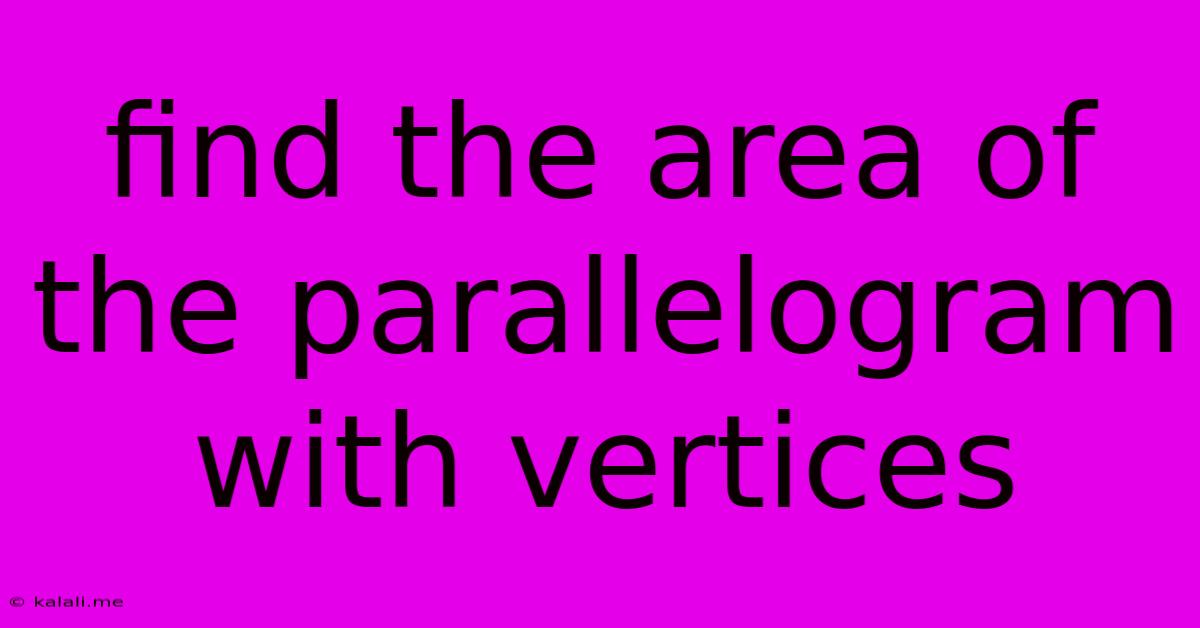Find The Area Of The Parallelogram With Vertices
Kalali
Jun 05, 2025 · 3 min read

Table of Contents
Finding the Area of a Parallelogram Given its Vertices
Finding the area of a parallelogram when you only know its vertices might seem tricky, but it's a straightforward process using vector math. This article will guide you through the steps, explaining the concepts clearly and providing examples. Understanding this method is crucial for various applications in geometry and computer graphics.
What you'll learn: This article will explain how to calculate the area of a parallelogram using its vertices, covering the underlying vector principles and offering practical examples to solidify your understanding. You'll learn about the cross product and its geometric significance in determining area.
Understanding the Parallelogram and its Vectors
A parallelogram is defined by four points (vertices) in a two-dimensional or three-dimensional space. Let's represent these vertices as vectors: A, B, C, and D. To find the area, we can use two adjacent vectors to form a parallelogram. For example, we can use vectors AB and AD, where AB = B - A and AD = D - A.
These vectors represent the sides of the parallelogram. The area of the parallelogram is directly related to the magnitude of the cross product of these two vectors.
The Cross Product and its Role in Area Calculation
The cross product (denoted by ×) is a binary operation on two vectors in three-dimensional space. The result is a vector that is perpendicular to both input vectors. The magnitude (length) of the cross product vector is equal to the area of the parallelogram formed by the two input vectors.
The cross product of two vectors u = (u₁, u₂, u₃) and v = (v₁, v₂, v₃) is calculated as:
u × v = (u₂v₃ - u₃v₂, u₃v₁ - u₁v₃, u₁v₂ - u₂v₁)
The magnitude of this resulting vector is:
||u × v|| = √((u₂v₃ - u₃v₂)²) + ((u₃v₁ - u₁v₃)²) + ((u₁v₂ - u₂v₁)²)
This magnitude is the area of the parallelogram formed by vectors u and v.
Calculating the Area: A Step-by-Step Example
Let's assume we have a parallelogram with vertices:
- A = (1, 2, 3)
- B = (4, 2, 1)
- C = (6, 5, 4)
- D = (3, 5, 2)
-
Find the vectors AB and AD:
- AB = B - A = (4 - 1, 2 - 2, 1 - 3) = (3, 0, -2)
- AD = D - A = (3 - 1, 5 - 2, 2 - 3) = (2, 3, -1)
-
Calculate the cross product of AB and AD:
- AB × AD = ((0)(-1) - (-2)(3), (-2)(2) - (3)(-1), (3)(3) - (0)(2)) = (6, -1, 9)
-
Find the magnitude of the cross product:
- ||AB × AD|| = √(6² + (-1)² + 9²) = √(36 + 1 + 81) = √118
Therefore, the area of the parallelogram is √118 square units.
Handling Two-Dimensional Parallelograms
If your parallelogram lies in a two-dimensional plane (e.g., the xy-plane), you can still use the cross product method. Simply treat the z-coordinate of each vertex as 0. The calculation will proceed as described above. Alternatively, you can use the determinant method. The area is simply the absolute value of the determinant of the matrix formed by the coordinates of the vectors representing two adjacent sides.
Conclusion
Calculating the area of a parallelogram given its vertices is a fundamental geometric problem with practical applications. This method, utilizing vector mathematics and the cross product, provides a robust and efficient solution. By understanding the underlying principles and following the steps outlined above, you can confidently determine the area of any parallelogram, regardless of its orientation or dimensionality. Remember to always check your calculations and consider using software or online calculators to verify your results, particularly for complex coordinate values.
Latest Posts
Latest Posts
-
How Cold Should My Ac Be In Car
Jun 06, 2025
-
Does Vodka Loses Alcohol In Heat
Jun 06, 2025
-
Can I Get A Hotel Room At 18
Jun 06, 2025
-
Harry Potter And The Resurrection Stone
Jun 06, 2025
-
What Does It Mean To Screw Someone
Jun 06, 2025
Related Post
Thank you for visiting our website which covers about Find The Area Of The Parallelogram With Vertices . We hope the information provided has been useful to you. Feel free to contact us if you have any questions or need further assistance. See you next time and don't miss to bookmark.